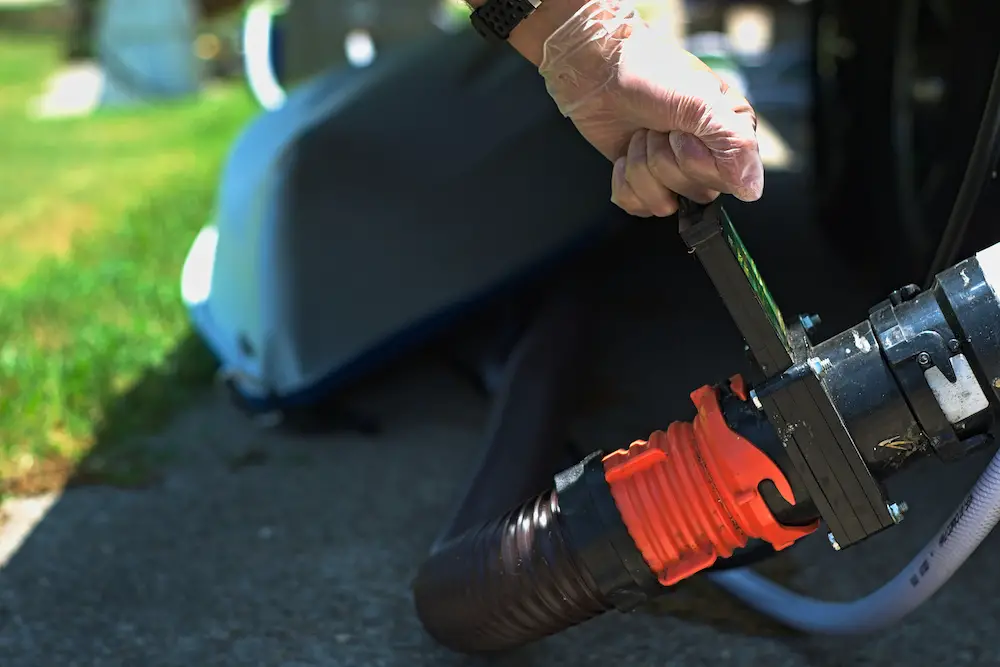Published Date: November 17, 2021
Last Updated on June 22, 2023 by Camper Front
Exploring the beauty of the countryside in an RV is fun and exciting. That is, until you get a water leak.
It’s one of the most common yet most challenging issues to deal with when living in an RV.
Left unchecked, a tiny moisture problem can grow into something as serious and costly to repair as a water-damaged roof.
This is the reason why you need to learn how to fix a water leak in a travel trailer.
Table of Contents
Spotting the Early Signs of Water Leaks
Especially when it comes to water leaks, prevention is always better than cure.
That said, you’ll want to make sure you seal everything to keep water and moisture out of areas they aren’t supposed to be at.
You should also pay close attention to any changes you’ll notice in your travel trailer.
For instance, one of the most obvious signs of water damage is interior stains.
Watch out for water stains on your walls and floors, discolored wood, bubbles in the paneling, and damaged lamination.
If you see any of these signs, there’s definitely a water leak somewhere in your trailer.
Interior materials exposed to water for some time will have a darker color, often a brownish hue.
Then, as mold begins to set in, they may turn black.
Speaking of which, mold is another major indication that your travel trailer has water damage.
It also means that water leaks have been there for quite a long time already.
Other signs are when exposed screws turn brown and rusty, caulking gets cracked or peels, or when the bottom compartments collect water.
How To Fix a Water Leak in a Travel Trailer
So, you’re sure there is a water leak in your trailer. What can you do to address the issue?
Going to a professional might be necessary if the problem is too big for you to handle.
However, you can also try going the DIY route first and hope it’s nothing too serious.
Step 1: Identify the Source
Leaks can occur from the roof, inside the cabinets and compartments, under the windows, and virtually any spot that has an opening.
That said, it can be challenging to figure out where the water is coming from exactly.
A good strategy to find the source of the water leak is by doing a water test.
You can use a garden hose with a nozzle set on a wide spray for this.
Basically, you will spray water throughout your RV while a family member or friend stays inside to check for leaks.
As you can imagine, this is a pretty simple test, but you need to take your time to ensure you cover everything, including the seams, roof vents, and sidings.
Start your water test from the ground up, and don’t forget the windows.
Alternatively, you can call an RV technician to do pressure testing work.
In this test, the technician creates air pressure inside the trailer that’s higher than the outside.
Then, the exterior of the travel trailer is then sprayed with soap and water.
The leak sources are determined when soap bubbles appear on the inside surfaces.
Step 2: Check the Roof
Punctures or holes on the roof, weak seams, and loose sidings are the most common sources of water leaks in RVs or travel trailers.
How do you fix a leaking roof on a travel trailer?
Firstly, conduct a thorough inspection of both the exterior and interior.
For interior checks, start by checking the ceiling for stains and then move on to the interior walls.
Outside, pay extra attention to areas around the vents and the HVAC systems.
These areas are the most prone to leaking because the sealants around them will dry up after some time.
The next step is to apply a temporary fix, such as a rubber patch.
It isn’t always possible to completely repair a roof the first time you notice it, especially when you’re on vacation.
Hence, it helps to find a temporary solution so that the damage doesn’t get any worse.
You can also apply sealants over seams and around the rooftop HVAC and air vents.
As soon as you arrive home from your vacation, take your travel trailer to a shop for a permanent fix.

Step 3: Inspect the Walls
Water leaks on walls can come from many sources, such as the roof or under the areas where the windows and walls meet.
Wear a pair of gloves and touch those areas or sections for any loose parts.
Depending on the size of the hole or the severity of the damage, you may be able to patch it up yourself.
There are many types of sealants you can use for patching holes.
If you’re dealing with exceptionally damp sections, use polysulfide sealant for better adhesion.
Step 4: Examine Each Window
If the leaks are coming from the edges or sides of the window, you don’t usually need to replace them unless you’re dealing with broken windows.
Instead, you can probably do away with replacing just the seal.
Sealing your travel trailer windows is very easy, and it doesn’t require fancy tools.
All you need are some basic supplies, such as some sealant tape, elastomeric sealant, cleaning alcohol, and a putty knife.
Follow these steps to fix water leaks in RV windows:
- Unscrew the interior of your window frame so that you can remove the clamp ring that holds it in place.
- Then, remove the window carefully. Have someone gently push it outwards from the inside while you hold it from the outside.
- Remove the old sealant using the putty knife.
- Clean the window and remove dust, dirt, and debris.
- Lastly, apply a new coating of sealant and re-install the window.
Step 5: Check the Sidings
Loose sidings are a common source of water leaks in travel trailers.
It’s important to determine what kind of siding your RV has, as different materials require different repair methods.
For instance, you can address holes in aluminum sidings caused by corrosion by patching them.
To do this, start by sanding the holes to remove the rust and then clean it using a damp cloth with a little liquid soap.
Next, apply some metal primer to the exposed edges and let it dry.
At this point, you can fill the holes with waterproof caulk. You’ll want to smooth the caulking and let it dry.
On the other hand, you can repair loose sidings by replacing the screws.
If you see delamination on the sidings, you may need to have the whole side or section replaced.
Step 6: Inspect Bottom Part of RV
Sometimes, water leaks come from under a travel trailer.
As you can imagine, it won’t be easy to spot. The water doesn’t enter your living space because it’s usually from a leaking tank or pipe.
If you notice a small leak or puddle after moving your trailer from its parking space, you may have a leak from the bottom of your RV.
In this case, it helps to know some troubleshooting tips for RV water systems.
Restoring Water Damage
Fixing water leaks involves restoring the damage and replacing damaged areas when necessary. Here’s what you can do:
Step 1: Clean the Area
Damaged parts of an RV or travel trailer need to be properly cleaned before they are fixed and restored.
Mild to slightly severe forms of water damage can be remedied using a water + bleach solution.
Simply mix one part of bleach with four parts of water, pour into a spray bottle, and spray it directly on the damaged area.
Let it soak before scrubbing it off with a brush or cloth.
Step 2: Check for Mold
However, if there’s mold, you may need the help of a mold remediation company.
Should you decide to handle the mold removal job yourself, always wear the proper protective gear, like a face mask and a pair of gloves.
Step 3: Dry Everything
After cleaning the damaged area, air it out until it’s completely dry.
You can open your trailer’s windows and doors for the entire day so that air can flow freely.
It’s also for the best if you take out removable furniture and accessories so that they can air-dry.
Some even use an air blower, which provides additional ventilation to remove excessive moisture caused by water damage.
Finally, replace damaged parts that can no longer be saved.
Step 4: Use the Right Sealing Product
More than anything else, you’ll want to think about the correct sealant to use to cover holes on your travel trailer.
You’ll find a specific type for different surfaces, such as for fiberglass, sheet metal, or rubber.
It’s also a good idea to have the following supplies in your travel trailer just in case you need to patch a hole or puncture.
- Tapes Sealant or Patch
You can seal holes on roofs using a tape sealant or patch.
Plus, you can use it for holes, cracks, and gaps because it doesn’t dry out in the sun.
- Liquid Sealers
A liquid sealer is a good product you can apply to seal cracks and crevices.
That said, keep in mind that it’s a multi-purpose sealant that only offers a temporary fix.
Make sure to clean and prime the surface before applying this product.
- Caulks
You can use this type of sealant on different surfaces, even vertical ones. It flows nicely and levels out smoothly.
For the best results, choose a marine-grade adhesive sealant caulk that is water-resistant and long-lasting.
Fixing Travel Trailer Leaks
Knowing how to fix a water leak in a travel trailer is essential for a safe, comfortable, and enjoyable road trip.
Start by performing a water test to determine where the leak is coming from.
Note that while some water leaks are easy to spot, others can be tricky.
Never disregard the early signs of water damage so that you can avoid costly repairs and parts in the future.
It’s also good to have your vehicle checked and inspected annually, especially if you use it often.

